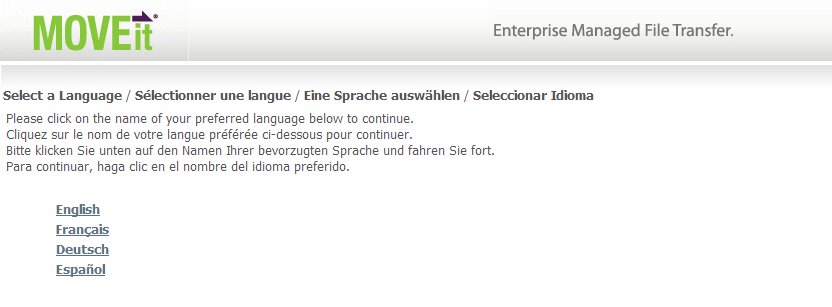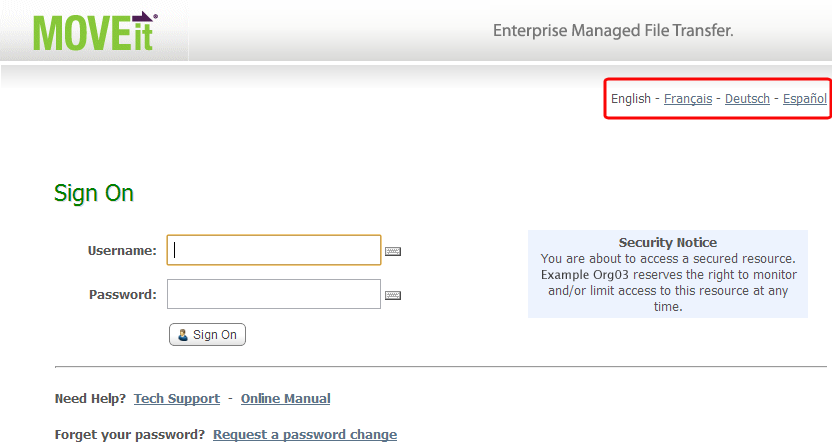(a.k.a. Localization or Internationalization or Translation)
The Web, FTP and SSH Interfaces of MOVEit DMZ (for end users) can be displayed in non-English languages. French, Spanish, and German are the non-English languages supported.
Note: In the interface, the name of each language is referred to in its own language, as: English, Français, Deutsch, and Español.
Administrators can set the organization's default language to one of the non-English languages.
In addition, end users can normally pick for themselves which language they wish to use. Their choice is recorded on their user profile and is also written to a cookie in their browser.
However, administrators can also configure their organization and users to prevent end users from selecting languages.
Each end user can be given several opportunities to select a language, even before signing on. User selection of language can occur at any or all of these three points when using the MOVEit desktop web interface:
Pre-Signon Language Select Page
In the style of many Canadian bilingual sites, MOVEit DMZ has an option which presents a dedicated screen that asks a user to pick a language before being presented with MOVEit DMZ's sign on page. The instructions are repeated in every language.

This page is enabled by default. When it is enabled, the end user's choice from this page will be remembered in a cookie in her browser, and this page will be suppressed as long as this cookie is available.
Note: Administrators can disable this page for their organization by going to Web Interface - Settings - Appearance - International - Interface. Turn off the Pre-Signon Language Select Page.
Sign On Page Language Selection Links
Also in the style of many Canadian bilingual sites, MOVEit DMZ can display links on the Sign on page to allow users to select a language before signing on. All available languages are displayed. (The actual link for the current language is inactive so users don't mistakenly think they need to click the current language before signing on.)

The language links on the Sign on page are enabled by default.
Note: Administrators can hide the language links for their page for users in their organization by going to Web Interface - Settings - Appearance - Display - Display Profiles, editing the Guest/Anonymous User Profile, and turning off Account Options | Display language selection.
Post-Signon Language Reconciliation "Change Language..." Page
If, in either the Pre-Signon page or the Sign On page, a user selects a language (e.g., English) that is different from the one currently listed in her user profile (e.g., Français), a Post-Signon Language Reconciliation Change Language... page may be presented to help MOVEit DMZ figure out which language to really use.

The page has three links:
The Change Language... page is not shown if any of the following is the case:
This page is similar to the page that prompts end users to download and install the MOVEit Wizard in that both pages are suppressed if an end user is following a link from a notification. In both cases, the purpose is to avoid making users click through numerous screens just to view a single file or package.
The Change Language... page is enabled by default.
Note: Administrators can hide the Change Language... page for end users in their organization by going to Web Interface - Settings - Appearance - Display - Display Profiles, editing the User Profile, and turning off Account Options | Display language selection. Do the same for the Temporary User Profile.
My Account Language Selection Option
After signing on, end users can change their language selection on their My Account page.

This section of the My Account page is hidden if the current user's display profile has the Account Options | Display language selection turned off.
This section of the My Account page is enabled by default.
Default Organization Language
Each organization administrator can selects a default language from the complete list of available languages. The default language controls the language in which the Sign on page is displayed when there is no input from language cookies and the Pre-Signon language select page is not available. The org-level default language also controls which language end users are set up under by default.
There is no single organization-wide restriction of available languages. If administrators want to enforce the use of the organization's default language, they must completely prohibit end users from changing language (doing this separately for the Pre-Signon page, the Sign On page, and for after sign on).
Permissions for End User Language Selection
User selection of language can occur at the Pre-Signon page, the Sign On page, and after sign on.
You configure these three points separately, and you can configure them in whatever combination suits your organization.
For the Pre-Signon page and the Sign On page, you configure each once for the organization. While all users see the Pre-Signon page and the Sign On page language links, any language selections made on those pages will only be effective for end users, not administrator users.
Note: As Guest/Anonymous User covers both Guest Users and other users who have yet to sign on, all three classes of end users are essentially being configured for the Sign on page: Users (including group admins), Temporary Users, and Guest Users.
Note: Unlike the Pre-Signon and Sign On permissions, the "after sign on" permissions can be configured differently for the two applicable user classes within the organization. You can configure them one way for Users (for example, enable language selection) and the other way for Temporary Users (for example, disable language selection).
Unlike end users, the administrator class of users - SysAdmins, Admins, and FileAdmins - will only see an English-only interface. (However, administrators arriving at the Sign on page may still be prompted for a choice of languages, especially if signing on from public terminals.)
Although international language support has been extended throughout the MOVEit DMZ product, not all administrative strings have been converted. The administrative interface, specifically administrative templates and the MOVEit DMZ Config and Check utilities, remains largely untranslated.
Some items which have been fully internationalized:
Some items which have NOT been fully internationalized:
Most MOVEit DMZ settings which support a text phrase can be properly internationalized. To delimit the phrases used for different languages, administrators use an intra-string [Language:XX] tag which indicates which message is for which language, where XX is fr, es, en or any other language code (ISO 639-1) which corresponds to a language MOVEit DMZ supports.
For example, consider the Custom Help Link Name. Today our link name is currently configured to be Ipswitch Home Page. If we wanted to display a Spanish version, we would enter a value like Ipswitch Home Page[Language:es]Ipswitch Casa Pagina into the Custom Help Link Name field and let the MOVEit DMZ code figure out which message (Ipswitch Home Page or Ipswitch Casa Pagina) to actually use based on the current user's language preference.
The following list briefly covers fields in MOVEit DMZ which are International-Ready because they support the [Language:XX] tags described above. Fields which begin with a name in parentheses are duplicates of another field mentioned elsewhere in this list.
Sign On Page:
Home Page:
Technical Support Page:
Custom Help:
Notification:
WebPost:
FTP Server:
All of the email notifications that are sent to end users, and most of the ones that go to administrators have been internationalized. The Custom Notification feature allows administrators the ability to edit the content of email notifications to override standard templates. When international language support is enabled, this feature also allows you to create and edit email notifications for each supported language.